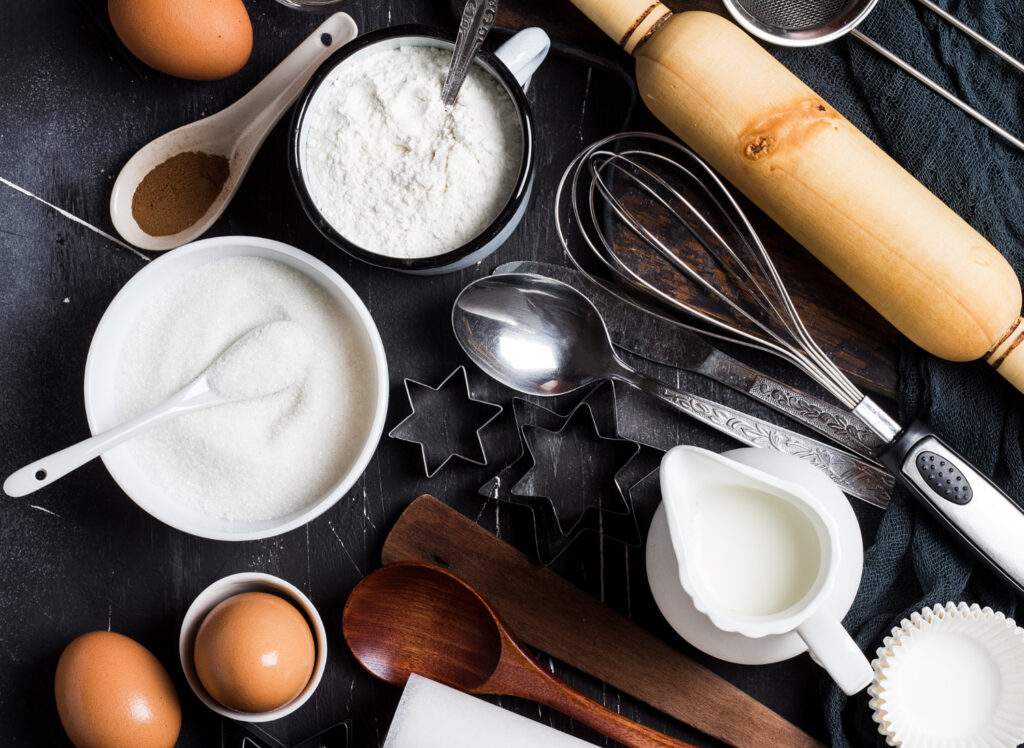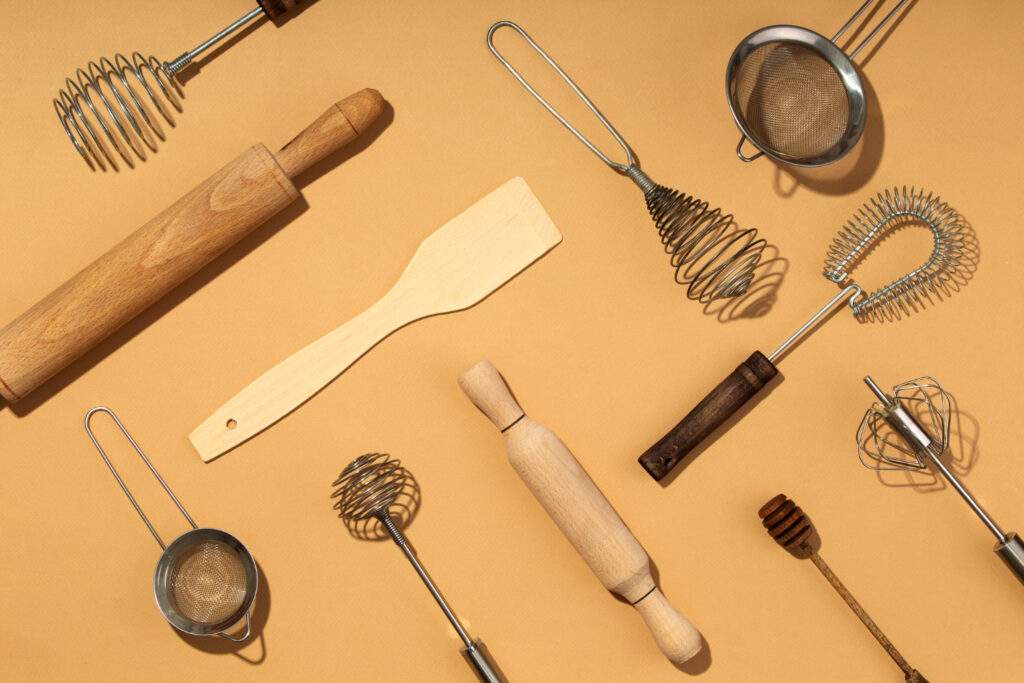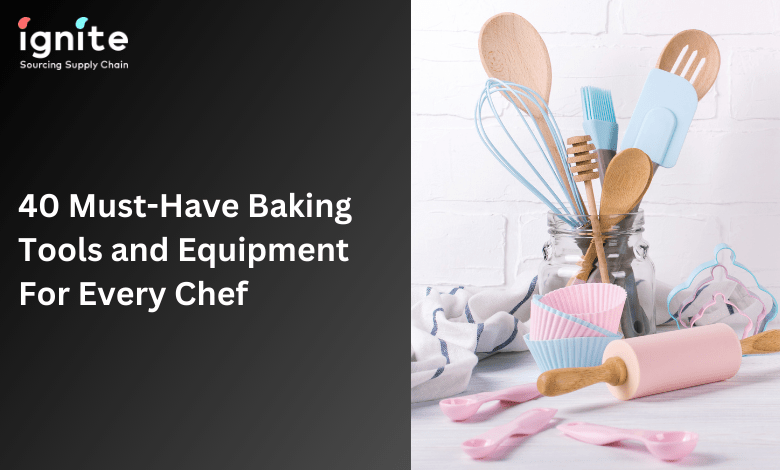Must-Have Baking Tools and Equipment
Baking can be a fun and rewarding hobby. But success requires the right tools and equipment. Having the right baking tools and equipment can make a big difference in the quality of your baked goods. Whether you’re a seasoned baker or starting out, you would need baking tools. In this article, we will examine 40 high-priority baking devices. We will gear that each cooking expert should have them in their kitchen. We have everything you need. From basic measuring tools like spoons and cups to more specialized items. These include pastry rings and bread lames, etc.
We’ll also give tips on the best way to keep your baking tools. And, how you can store your instruments to guarantee they keep going long into the future. Thus, how about we begin building your definitive baking tool stash?
Basic Tools
1. Cups and spoons for measuring
For baking, measuring cups and spoons are necessary tools. This is because accurate and consistent results require precise measurements. Plastic, metal, and glass are some of the materials and sizes of measuring cups and spoons.
Measuring cups are used to measure liquids like milk, water, and oil. They have a handle for stability and a spout for easy pouring. For dry ingredients like flour, sugar, and baking powder, measuring spoons are used. They arrive in a bunch of various sizes, including 1/4 teaspoon, 1/2 teaspoon, 1 teaspoon, and 1 tablespoon.
2. Blending Bowls
They are utilized for blending ingredients, like flour, sugar, and eggs, to make dough or batter. Blending bowls are available in a variety of sizes and materials. These include plastic, glass, and stainless steel.
Stainless steel blending bowls are the most durable choice. They can be used for a variety of tasks. These include mixing ingredients and whisking egg whites. They are also simple to clean. Non-reactive glass mixing bowls are another popular choice. Because they can be used to mix both hot and cold ingredients. Blending bowls made of plastic are less expensive. They are lightweight and simple to store.
3. Whisk
A whisk is a baking tool for mixing and aerating sauces, cream, and other ingredients. Whisks are made of metal wires that are wound together toward the end of a handle.
The state of the whisk decides the kind of blending it is most appropriate for. The round, bulbous shape of a balloon whisk makes it ideal for blending creams and batters. The flat shape of a flat whisk or roux whisk makes it ideal for mixing ingredients in a skillet or saucepan. The long, thin shape of a French whisk or spiral whisk, makes it ideal for whisking eggs or making smooth sauces.
While utilizing a whisk, it is vital to use a light touch and to keep away from overmixing the ingredients. Ingredients can break down or become too dense when they are overmixed. This results in a less appealing texture.

4. Spatula
A spatula is a flexible baking device. It is used for scratching bowls and collapsing fixings. It can also be used to flipping and serving prepared products. Spatulas are available in silicon, plastic, and metal form.
Because they are heat-resistant and flexible, silicon spatulas are popular among bakers. This makes them ideal for scraping bowls and folding ingredients. Metal spatulas are long-lasting. They can be used to flip and serve baked goods, whereas plastic spatulas are light and easy to clean.
5. Pin for rolling
To flatten and shape dough for pastries, cookies, and other baked goods, a rolling pin is essential.
The most common type of rolling pin is wooden pins. These are preferred by many bakers due to their durability and strength. Professional kitchens often use metal rolling pins. This is because of their weight and the speed at which dough cools. silicon rolling pins are ideal for home bakers who want an easy-to-use option. because they are lightweight and easy to clean.
6. Cake brush
When applying liquids to baked goods, such as melted butter or egg wash, pastry brushes are used. They are also available in a variety of sizes and materials. These include options like natural bristles and silicon.
7. Baking pans
Baking sheets are level metal sheets used for baking treats, cakes, and other heated items. Non-stick coatings and perforated options are available. They are also available in different sizes and materials.
8. Paper made of pine
To prevent food from sticking, baking sheets and pans are lined with parchment paper. They additionally make the cleaning system less complex. It comes in rolls or sheets that have already been cut, with some options being reusable.
Essential Equipment
9. Mixer stand
A mixer stand is a flexible and strong kitchen machine. It is used for blending and massaging the mixture, whipping cream, and beating egg whites. It usually comes with a paddle, whisk, and dough hook, among other things.
10. Hand mixer
A hand blender is a more modest and reasonable option in contrast to a stand blender. It is utilized for blending, whipping cream, and beating egg whites. It is a great choice for kitchens with limited space because it is small and simple to store.
11. Food processor
A food processor is a useful kitchen tool. It is used to shred cheese, chop nuts, and make pie crust, among other baking tasks. It has a variety of blades and attachments. These accommodate various recipes and ingredients.
12. Blender
A blender is another flexible kitchen machine utilized for pureeing and mixing materials. It can be used to mix batters and make smoothies, and fruit puree.
13. Thermometer for the oven
An oven thermometer is utilized to screen the temperature inside the oven. It guarantees that prepared food is cooked at the right temperature. The temperature of the oven can differ from that shown on the dial. So, it is important to have an accurate oven thermometer.
14. Digital Kitchen Scale
A digital kitchen scale is a fundamental device for the exact estimation of fixings. It can be used to weigh ingredients like flour, sugar, and butter. It is more accurate than measuring cups and spoons.
15. Baked good shaper
A baked good shaper is used for cutting spread or shortening into flour while making pie hulls or rolls. It has a number of wires or sharp blades that easily and quickly cut through butter or shortening.
16. Blender for cakes
A blender for cake is a comparable instrument to a cake shaper. It is used for cutting spread or shortening into flour. It chops butter or shortening into small pieces with a series of U-shaped wires or blades.
17. Scraper for the dough
A dough scraper is a tool for breaking the dough into smaller pieces and scraping it off. Additionally, it is used to remove flour and mixture from a work surface.
18. Bench Scraper
A bench scraper is a larger version of a dough scraper. It is used to clean up work surfaces and cut and divide dough. A flexible device can likewise be utilized for moving hacked vegetables and spices.

Special Baking Tools
19. Baking pan
Any home baker needs a good set of baking pans. They can be made of metal, glass, or silicon. They come in a variety of sizes and shapes to accommodate various recipes. Cake pans, muffin pans, and baking sheets are all common types of baking pans.
They can be of varying depths to accommodate various cake recipes. The bottoms of some cake pans can be removed. This makes it easier to remove the cake and make a beautiful presentation.
20. Springform pan
Cheesecakes, tarts, and other delicate desserts that are difficult to remove from a traditional pan are baked in a springform pan. There are two parts to the pan: a removable ring that fits around the base and a circular base. The ring is held in place by a spring or latch that can be released, allowing the pan’s sides to be removed from the base.
Springform pans come in a variety of sizes and are made of metal, such as stainless steel or aluminum. Their diameters range from 6 to 12 inches. They may likewise have non-stick coatings to prevent sticking and make cleaning simpler. A few models might have silicon seals to prevent breaks and spills.
21. Tart pan
A baking pan with a fluted edge is used to make tarts or pies.
To use a tart pan, prepare the crust or pastry dough. The dough can be transferred to the tart pan. It should be done evenly for obtaining the desired finishing. The tart pans have removable bottoms. It is simpler to remove the tart from the pan and create a beautiful presentation.
22. Loaf pan
Bread, pound cakes, meatloaf, and other baked goods are made in a rectangular loaf pan. They can be found in a variety of sizes to accommodate various recipes. They are made of silicon, glass, or metal.
Pour the batter or dough into the greased loaf pan. Prepare it according to the recipe’s instructions. Portion skillets with non-stick coatings or silicon materials are simpler to clean. They can prevent sticking. Metal pans are sturdy and can create a crispy crust on bread.
23. Cupcake pan
A cupcake pan is a baking tool used to create individual cupcakes or muffins.
Pour the prepared batter for a cupcake or muffin into each cup of the cupcake or muffin pan. Be careful not to overfill the cups to prevent spills and uneven baking. After baking the cupcakes, remove them from the pan and allow them to cool. Metal pans are durable and can produce better browning on the sides and bottom of the cupcakes. While non-stick pans are easier to use and clean.
24. Cookie Cutters
Cookies can be made in a variety of shapes and sizes with the help of cookie cutters. They come in a wide variety of designs. Designs may range from straightforward geometric patterns to more intricate patterns. These may feature animals, letters, and seasonal motifs. Cookie cutters are produced using metal, plastic, or silicon. They come in sets as well as individual pieces.
Roll out your cookie dough to the thickness you want it to be. Now, press the cutter into it to get the shape you want. You can then eliminate the extra dough from the edges of the shaper and move the slice-out cookie to a baking sheet.
25. Pastry Bags
Pastry bags are plastic, silicon, or cloth bags with a cylinder shape. They are used in baking to decorate and fill cakes, pastries, and other baked goods. They are combined with a variety of pastry tips to create various patterns and designs.
Depending on the material used, pastry bags can be disposable or reusable. Plastic or parchment paper are the materials for disposable pastry bags. They can be used only once. Reusable bags are made of silicon or cloth and can be washed and used again.
When using a pastry bag, it is essential to fill it correctly and not overfill it. This can result in the frosting or filling spilling out. When squeezing the bag, even pressure is also essential for consistent results.
26. Decoration Tips
When decorating cakes, cupcakes, and other baked goods, decorating tips are used. They are small, metal attachments that attach to the end of a pastry bag. They can be used to create a variety of shapes and designs. You can make round tips for making borders and dots or star tips for making rosettes and swirls. They come in various sizes and shapes.
Attach the desired tip to the end of a pastry bag before filling it with frosting or icing. Use consistent, even pressure to squeeze the bag into the shape you want. You can create a wide range of designs, from borders and dots to more intricate patterns and shapes. You can try out a variety of tips and methods.
27. Leveler for the cake
A cake leveler is a heating instrument used to cut through the top of a cake to make an even, level surface. This is significant to make the layers of the cake equal. Cake levelers have a long, serrated blade. It can be positioned at various heights to achieve the desired cake layer thickness.
Adjust the blade to the desired height before slicing through the cake’s top with a cake leveler. Avoiding pressing too hard on the cake. It can make the cake uneven
28. Offset Spatula
The offset spatula is a versatile baking tool. Spreading, smoothing, and frosting cakes, cookies, & other baked goods are done with an offset spatula. It has a long, narrow, flexible blade that is offset from the handle at an angle. This design permits the user to venture into tight spaces and point to the edge for complete control. It allows application without any problem.
They may have handles made of metal, plastic, or wood that are comfortable to hold.
29. Pastry wheel
In baking, a pastry wheel is a tool for cutting and shaping the dough. It typically consists of a handle and a sharp metal blade. They are available in several forms. These include fluted and straight edges. The straight edge is commonly used for cutting the dough into strips. While the fluted edge is often used for decorative edges on pastries and dough.
Pastry wheels are used for cutting lattice crusts for pies and trimming dough for empanadas. They are also used in making ravioli and cutting decorative edges for pastries, etc.
They can likewise be utilized to cut fondant for cake decorations.
30. Baking stone
Baking stones are made of cordierite, clay, or ceramic. They are designed to evenly retain and disperse heat.
Baking stones are used to prepare bread, pizza, and other heated materials that need a crisp crust. The permeable surface of the stone retains moisture from the batter. This brings about a firm and evenly cooked crust. Baking stones are also used as a grilling surface.
Before baking, a baking stone must be preheated in the oven for at least 30 minutes. The dough is then directly placed on the stone’s hot surface. This helps to transfer heat and produce a crispy crust. Baking stones are also great for use with a pizza strip. It permits you to slide the batter onto the stone easily.
31. Bread Lame
A bread lame is a baking tool for scoring or cutting through bread dough. It has a handle and a razor blade that are fastened at an angle of 90 degrees to it.
Before baking, bread lames are used to score the surface of the dough. By scoring the dough, the bread can properly expand in the oven. It gives the cake a light, airy texture and a crispy crust. A bread lame’s cuts can also leave decorative patterns on the bread’s surface.
The blades on a bread lame are replaceable. They can be made of various materials, for example, treated steel or carbon steel. Some bread lames have bent or bowed blades to assist with angled cuts.
Miscellaneous Tools
32. Cooking timer
To accurately measure and keep track of the baking time, a kitchen timer is an essential baking tool. It notifies you when the desired baking time has passed. This helps you avoid overcooking or undercooking. A clock with different commencement or alarm elements is valuable when doing various baking tasks simultaneously. Baking bread, cakes, or cookies is easier with a kitchen timer.
33. Cooling racks
A cooking rack is a baking tool used to cool baked goods after they are removed from the oven. They allow hot items to cool evenly and quickly with their excellent air circulation. The elevated design prevents condensation buildup. It keeps up with the freshness of pastries, baked goods, and cakes. Additionally, cooling racks prevent the accumulation of moisture. This help preserves the texture and freshness of your baked goods.
34. Kitchen light
The kitchen light is an essential tool for baking. It ensures proper visibility and illumination while working in the kitchen. It assists you with measuring ingredients and reading recipes. They also help in screening the advancement of your baked food. A sufficiently bright kitchen lessens the possibility of mistakes and guarantees steady results. Moreover, a decent lighting arrangement enhances safety. This prevents accidents and allows you to easily navigate your workspace.
35. Candy thermometer
A candy thermometer is a crucial baking tool. It helps in tasks like making caramel, toffee, fudge, and other confections that need temperature control. You can use it to keep an eye on the temperature of the sugar syrup or melted chocolate. You can ensure that it reaches the right consistency and texture. When making delicate confections, a candy thermometer with a long probe is used. A temperature scale allows you to accurately measure and maintain the temperature. Using a candy thermometer helps you get consistent results. It helps keep your sweet creations from being undercooked or overcooked.
36. Thermometer with instant readout
A baking tool that measures the internal temperature of baked goods like bread or cakes is a thermometer with an instant readout. It makes sure that the food is cooked properly. You can accurately determine when your baked goods are done by using its quick response time. It prevents over- or underbaking. It’s a useful tool for baking that helps you get the best results and maintain consistent quality.
37. Cake mat
Cake mats are useful baking tools. They are used for working with dough, fondant, or other delicate mixtures. They provide a nonstick surface. During baking, it helps prevent sticking and ensures an even distribution of heat. Moreover, a cake mat is used as an aide for carrying out a mixture to accomplish steady thickness for perfectly baked goods.
38. Pastry rings
Pastry rings are also known as cake rings or baking rings. They are versatile baking tools. They are used to make pastries, cakes, and desserts that are perfectly shaped and layered. These metal rings come in different sizes and shapes. These allow you to make various presentations and piece sizes. Pastry rings are great for making uniform tart shells and layered desserts. For example, mousse cakes because they give baked goods a clear shape and structure. They can also be used in plating individual portions and presenting them in a professional and appealing way.
39. Cake stamps
Cake stamps are also known as cake embossing stamps. They are decorative baking tools that are used to decorate cakes and other baked goods with intricate designs or patterns. They have raised patterns or imprints. They are made of food-safe materials like silicon or plastic. You can create beautiful and intricate designs. These will help enhance the visual appeal of your creations by pressing the stamp onto the cake’s surface. Cake stamps are a simple yet efficient method for enhancing the elegance and creativity of your baked goods.
Maintenance and Storage
Tips for cleaning and maintaining baking tools and equipment
1. Read the manufacturer’s instructions
Before cleaning your baking tools, read the manufacturer’s guidelines to try not to damage them.
2. Hand wash
While hand washing your baking tools, it’s important to use a gentle dish cleanser. Specific kitchen cleaners are also available. Harsh synthetic cleaners should be kept away. They might harm the surfaces of your tools.
After you wash the baking tools, completely dry them with a clean towel or let them air dry. Moisture can prompt rust and erosion, particularly on metal tools.
To ensure proper upkeep and long-term use, it’s best to follow the manufacturer’s specific care instructions.
3. Proper storage
To keep your baking supplies and tools safe from damage, store them in a dry, clean place. Keep them coordinated.
4. Regular cleaning
Your baking tools and equipment can last longer if you clean and maintain them on a regular basis. Clean them as soon as possible before they become rusty or heavily soiled.
5. Apply baking soda
On baking sheets and pans, you can use baking soda to remove stubborn stains and grease. Blend baking soda and water into glue and apply it to the surface. Then let it sit for a couple of moments before scouring and washing with water.
6. Apply vinegar
Baking equipment and tools made of metal can be de-rusted with vinegar. After soaking the item for a few hours in vinegar, scrub it with a brush or sponge and then rinse it with water.
7. Sharpen blades
Sharpen dull blades on scrapers, cutters, and knives. A sharp blade will make it more simple to work with and prevent harm to your prepared food.
8. Replace worn-out tools
To avoid accidents and ensure consistent baking results, replace your worn-out or damaged baking tools.
9. Examine for food residue
Before putting away your baking tools, ensure you clean them for any food residue. This will stop the growth of bacteria and ensure that they are prepared for your next baking project.
Proper storage techniques to prolong their lifespan
Your baking tools and equipment can last longer if you store them properly. Here are a few tips:
1. Store in a dry place
Metal tools can rust and become corroded from moisture. To avoid damage, store your baking supplies and tools in a dry location.
2. Keep Organized
To keep your baking tools and equipment easily accessible and to prevent damage accumulation, arrange them by type and size.
3. Use covers that are safe
To protect your baking tools and equipment from scratches and other forms of damage, use covers made of plastic or silicon.
4. Store the blades securely
To avoid harm and accidents, knives and other bladed tools should be stored in protective covers or sheaths.
5. Avoid direct heat
To avoid warping and other damage, keep your baking tools and equipment away from direct heat sources like ovens and stovetops.
6. Use stackable compartments
Space can be saved and your baking tools can be organized with stackable containers. Check that the containers can be stacked and are sturdy.
7. Name compartments
Label your containers for storage to make it easy to find the tools and equipment inside.
8. Store in original packaging
To keep your baking tools and equipment safe from damage, keep them in their original packaging whenever possible.
9. Regularly clean and inspect
Clean and check your baking tools and equipment on a regular basis for wear and tear. This will assist you with getting any issues early and prevent any further harm.
Conclusion
In conclusion, whether you’re a home baker or a professional chef, you need the right baking tools and equipment. The right equipment can make a big difference in how your baked goods turn out. From basic tools like measuring cups and mixing bowls to special tools like cake pans and decorating tips.
In addition to improving your baking skills, investing in high-quality supplies can save you time and money. Taking care of your tools can make them last longer and ensure consistent results.
Having the appropriate tools can assist you in achieving the ideal texture, flavor, and presentation of your baked goods. Therefore, if you want to take your baking skills to the next level, don’t be afraid to spend money on high-quality products.
Look no further than ‘IgniteSupplyChain‘ for a trustworthy sourcing company. You can trust the sellers you buy from. Our platform has a wide selection of products from verified suppliers. We have a rigorous verification process. We deal in all kinds of products to cater to your individual and business requirements.
For custom products manufacturing related queries please visit EverLighten.com
FAQs
Measuring cups, spatulas, spoons, pastry brushes, and whisks are some important tools used to bake a cake. A wide, flat, and flexible kitchen tool known as a baking spatula. It is used to spread, smooth, and lift baking ingredients. A grater is a baking tool having a rough surface. It is used in cutting any food item into small pieces. An oven is the most important baking tool. Some other important baking tools include a rolling pin, cookie cutter, measuring cup, whisker, etc. What are the tools used to bake a cake?
What is a baking spatula?
Is a grater a cutting tool?
What is the most important baking tool?



